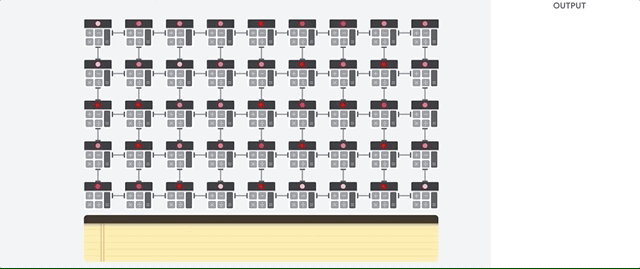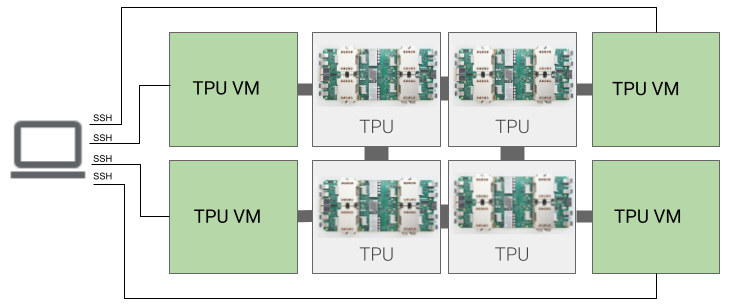TPU 架構
Tensor Processing Unit (TPU) 是 Google 設計的特殊應用積體電路 (ASIC),用於加速機器學習工作負載。Cloud TPU 是一項 Google Cloud 服務,可將 TPU 做為可擴充資源。
TPU 的設計宗旨是快速執行矩陣運算,因此非常適合機器學習工作負載。您可以使用 Pytorch 和 JAX 等架構,在 TPU 上執行機器學習工作負載。
TPU 的運作方式
如要瞭解 TPU 的運作方式,有助於瞭解其他加速器如何解決訓練 ML 模型的運算挑戰。
CPU 的運作方式
CPU 是以 von Neumann 架構為基礎的通用處理器。這表示 CPU 可與軟體和記憶體搭配使用,如以下所示:

CPU 的最大優點是其彈性。您可以在 CPU 上載入各種軟體,用於許多不同類型的應用程式。舉例來說,您可以使用 CPU 在 PC 中進行文字處理、控制火箭引擎、執行銀行交易,或使用類神經網路將圖片分類。
CPU 會從記憶體載入值、對值執行計算,並將結果儲存回記憶體,以供後續計算使用。與計算速度相比,記憶體存取速度較慢,可能會限制 CPU 的總輸送量。這通常稱為「馮紐曼瓶頸」。
GPU 運作方式
為了獲得更高的總處理量,GPU 在單一處理器中包含數千個算術邏輯單元 (ALU)。新型 GPU 通常包含 2,500 至 5,000 個 ALU。這麼大量的處理器表示您可以同時執行數千個乘積和加法。

此 GPU 架構可在具有大量平行運作 (例如類神經網路中的矩陣運算) 的應用程式上順利運作。實際上,在深度學習的典型訓練工作負載上,GPU 可以提供較 CPU 高幾十倍的總處理量。
但 GPU 仍是通用處理器,可支援許多不同的應用程式和軟體。因此,GPU 與 CPU 有相同的問題。對於數千個 ALU 中的每個計算,GPU 必須存取暫存器或共用記憶體來讀取運算元,並儲存中繼計算結果。
TPU 運作方式
Google 將 Cloud TPU 設計為類神經網路工作負載專用的矩陣處理器。TPU 無法執行文書處理程式、控制火箭引擎或執行銀行交易,但可以快速處理類神經網路使用的大量矩陣運算。
TPU 的主要工作是矩陣處理,也就是乘法和累加運算的組合。TPU 包含數千個直接相互連接的乘法累計器,可形成大型實體矩陣。這稱為脈動陣列架構。Cloud TPU v3 含有兩個 128 x 128 ALU 的脈動陣列,位於單一處理器上。
TPU 主機會將資料串流至饋入佇列。TPU 會從送入佇列載入資料,並儲存在 HBM 記憶體中。運算完成後,TPU 會將結果載入出料佇列。接著,TPU 主機會從出給佇列讀取結果,並將結果儲存在主機的記憶體中。
為執行矩陣運算,TPU 會將參數從 HBM 記憶體載入至矩陣乘法單元 (MXU)。

接著,TPU 會從 HBM 記憶體載入資料。執行每個乘法時,結果會傳遞到下一個乘法累加器。輸出即是資料和參數間所有乘法結果的總和。在矩陣乘法過程中,完全不需要記憶體存取權。

因此,TPU 可以在類神經網路計算時達到較高的運算總處理量。
TPU 系統架構
以下各節說明 TPU 系統的重要概念。如要進一步瞭解常見的機器學習用語,請參閱機器學習詞彙表。
如果您是 Cloud TPU 新手,請參閱 TPU 說明文件首頁。
TPU 晶片
TPU 晶片包含一或多個 TensorCore。TensorCore 數量取決於 TPU 晶片版本。每個 TensorCore 都包含一或多個矩陣乘法單元 (MXU)、向量單元和純量單元。如要進一步瞭解 TensorCore,請參閱這篇文章。
MXU 由 256 x 256 (TPU v6e) 或 128 x 128 (v6e 之前的 TPU 版本) 的乘法累加器組成,位於脈動陣列中。MXU 可在 TensorCore 中提供大部分的運算能力。每個 MXU 在各個週期中都能執行 16000 次乘積累加運算。所有乘法運算都會採用 bfloat16 輸入,但所有累加運算都會以 FP32 數字格式執行。
向量單元用於一般運算,例如啟用和 Softmax。 純量單元用於控制流程、計算記憶體位址,以及其他維護作業。
TPU Pod
TPU Pod 是透過專用網路分組的連續 TPU 集合。TPU Pod 中的 TPU 晶片數量取決於 TPU 版本。
配量
配量是一組晶片,全都在同一個 TPU Pod 內,並透過高速晶片間互連 (ICI) 網路連線。配量是以晶片或 TensorCore 來說明,視 TPU 版本而定。
晶片形狀和晶片拓撲也指切片形狀。
多配量與單一配量
Multislice 是一組配量,可將 TPU 連線擴展至晶片間互連 (ICI) 連線以外,並運用資料中心網路 (DCN) 傳輸配量以外的資料。每個切片中的資料仍會透過 ICI 傳輸。透過這種混合式連線,多配量可啟用配量間的平行處理,讓您為單一工作使用的 TPU 核心數量,超過單一配量可容納的數量。
TPU 可用於在單一或多個切片上執行工作。詳情請參閱多切片簡介。
TPU 立方體
互連 TPU 晶片的 4x4x4 拓撲。這項功能僅適用於 3D 拓撲 (從 TPU v4 開始)。
SparseCore
SparseCores 是 Dataflow 處理器,可加速使用稀疏作業的模型。主要用途是加速建議模型,這類模型非常依賴嵌入。v5p 每個晶片包含四個 SparseCore,v6e 每個晶片包含兩個 SparseCore。如需深入瞭解 SparseCore 的使用方式,請參閱「A deep dive into SparseCore for Large Embedding Models (LEM)」。您可以透過 XLA 旗標,控管 XLA 編譯器使用 SparseCore 的方式。詳情請參閱: TPU XLA 旗標。
Cloud TPU ICI 復原能力
ICI 韌性有助於提升光纖連結和光纖電路交換器 (OCS) 的容錯能力,這些連結和交換器會連接立方體之間的 TPU。(立體架構內的 ICI 連線使用不受影響的銅線連結)。 ICI 韌性可讓 ICI 連線繞過 OCS 和光纖 ICI 故障進行路由。因此,這項功能會改善 TPU 節點的排程可用性,但 ICI 效能會暫時下降。
對於 Cloud TPU v4 和 v5p,預設會為一個或多個立方體大小的配量啟用 ICI 復原功能,例如:
- 指定加速器類型時為 v5p-128
- 指定加速器設定時為 4x4x4
TPU 版本
TPU 晶片的確切架構取決於您使用的 TPU 版本。每個 TPU 版本也支援不同的切片大小和設定。如要進一步瞭解系統架構和支援的設定,請參閱下列頁面:
TPU 雲端架構
Google Cloud 透過 TPU VM 提供 TPU 做為運算資源。您可以直接使用 TPU VM 執行工作負載,也可以透過 Google Kubernetes Engine 或 Vertex AI 使用。以下各節說明 TPU 雲端架構的主要元件。
TPU VM 架構
透過 TPU VM 架構,您可以使用 SSH 直接連線至實體連接 TPU 裝置的 VM。TPU VM 也稱為工作站,是執行 Linux 的虛擬機器,可存取基礎 TPU。您擁有 VM 的根目錄存取權,因此可以執行任意程式碼。您可以存取編譯器和執行階段的偵錯記錄和錯誤訊息。

單一主機、多主機和子主機
TPU 主機是 VM,在連線至 TPU 硬體的實體電腦上執行。TPU 工作負載可使用一或多個主機。
單一主機工作負載最多只能有一個 TPU VM。多主機工作負載會將訓練分散至多個 TPU VM。子主機工作負載不會使用 TPU VM 上的所有晶片。
TPU 節點架構 (已淘汰)
TPU 節點架構包含使用者 VM,可透過 gRPC 與 TPU 主機通訊。使用這種架構時,您無法直接存取 TPU 主機,因此難以偵錯訓練和 TPU 錯誤。

從 TPU 節點架構遷移至 TPU VM 架構
如果您有使用 TPU 節點架構的 TPU,請按照下列步驟識別、刪除並重新佈建為 TPU VM。
前往 TPU 頁面:
在「架構」標題下方,找出您的 TPU 和其架構。 如果架構是「TPU VM」,則不必採取任何行動。如果架構為「TPU 節點」,您需要刪除並重新佈建 TPU。
刪除並重新佈建 TPU。

